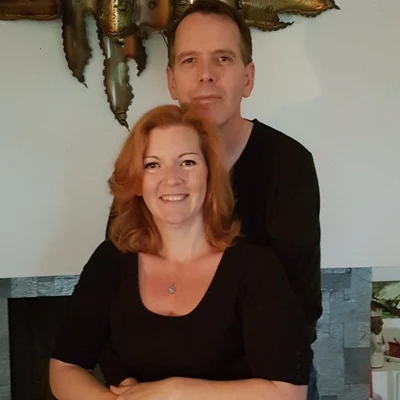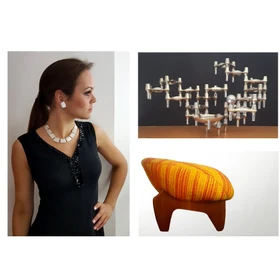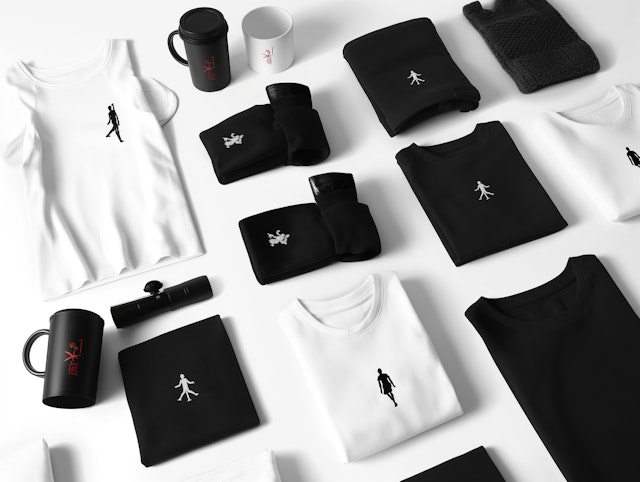How VintageChicDream got started
Introduce your Etsy shop and tell us your story. How did you begin and decide on what to sell on Etsy, and how do you create your products?
Our shop is called VintageChicDream. We began in 2016, when a friend’s mother passed away. She had been a representative of a jewelry company in the 1970s, and when the company folded, they left her with thousands of pieces of jewelry. Thousands… We wanted to find a venue on which to sell them, and after researching a few online platforms, Etsy came to the top of the list. We soon started offering pieces from our personal vintage and mid-century modern collection, such as home décor items, art, and the occasional piece of furniture. After a bit of success, we began actively seeking out items to sell, and within two years, we turned our shop into a full-time business. More recently, we have offered ourselves as a consignment business—we sell for people who might not have enough items to open their own store or older folks who are downsizing. In the internet age, it’s easy for people to determine how much a specific item is worth, but they might not have the time, knowledge, or tools to offer the item outside of their local marketplace. We’re able to use our Etsy shop to offer their items to a global audience.
Favorite items
What are your favorite items? What makes these so special? Why do you think these items might be selling well?
Our favorite items are from the mid-century modern or Danish modern period, from the 1950s to the 1970s. Since we sell vintage, we don’t get a large number of any specific item. Generally, we love to collect art glass and vintage pottery and sell as our collections become too large.
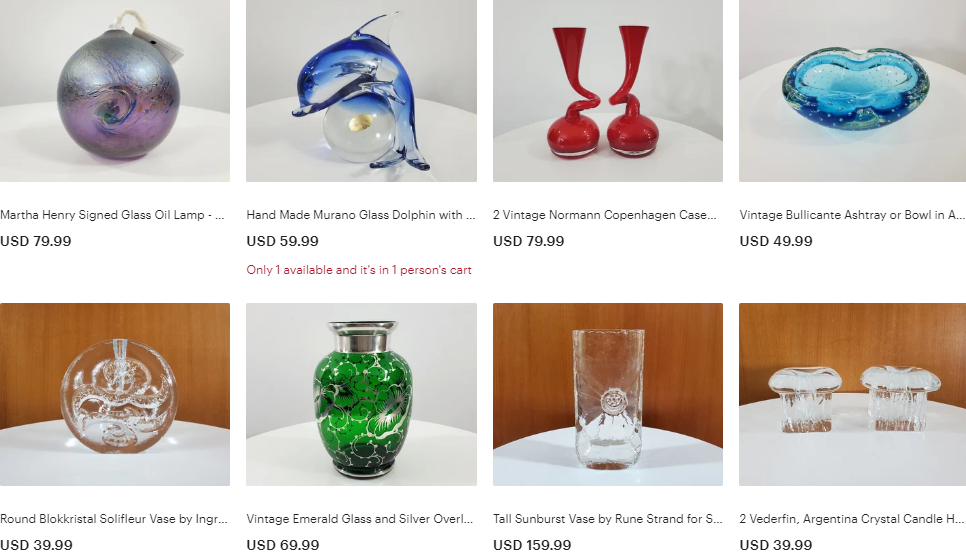
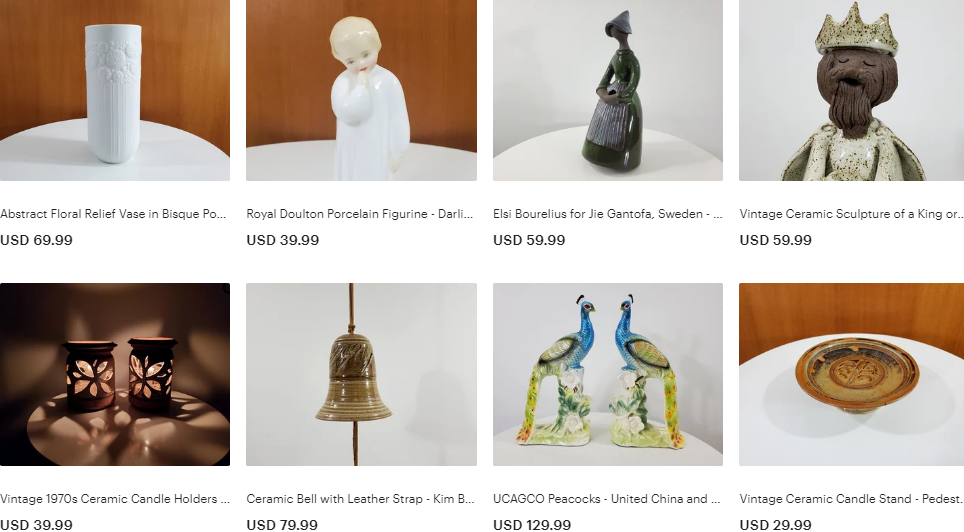
Nothing specific is a "fast" seller, but we find glass and ceramics to be steady sellers. Lighting is also a steady seller. Whether it’s a stand-alone lamp or something that needs to be wired into a home, lighting is always popular. As for that original assortment of jewelry, a simple rhodium-plated man’s ring with a square onyx inset has been the best seller; we’ve sold hundreds of them and are now out of stock.
Getting sales on Etsy
How long did it take for you to earn your first sale and how do you currently attract customers to your Etsy shop?
Our first sale was probably seven days after we opened up our shop. It was a funky little lamp, and we shipped it to California. We used to constantly check our shop’s recent activity to see what items people were viewing. We have used Instagram and Facebook to promote our shop, but we’ve found that through those apps, we were promoting other sellers. Our primary source of promoting our store is through Etsy itself. We do pay a daily amount to promote through Etsy and feel that that is quite important. We also have old-fashioned business cards that we hand out, and of course, we can email or text links to the store.
Managing VintageChicDream
How do you manage your shop? Are you running solo or do you have any team members? What tools or services do you use to run your shop and how do you handle fulfillment?
It is only the two of us actively working on the store. Our first step is to find items to sell. We look online, through vintage stores, estate sales, et cetera. Of course, with consignment, we’re visiting people and talking to them about their items and how we can maximize their price while also taking a percentage for ourselves. We’re constantly doing research when we find something with which we’re not familiar. After we get a few items to sell, we clean them and test them if necessary. We’re pretty hard-core about that. We’ll often take things such as appliances or radios apart and get as much grit and grime off of them as possible. We have various polishers and cleaners; we definitely want our items to look their best. There are some exceptions. Brass, for example, often has a great, aged patina, and you want to preserve it.
When we buy an item to sell, we inventory it. We use Excel to document what it is, when we bought it, how much we paid, et cetera. This is primarily for tax purposes. I never thought that this little business would generate enough income that we had to register it as a business! We have a small little photo area where we are able to switch between a basic white wall or wood wall background. As the white wall gets dinged up or acquires nail holes, we use a free program called GIMP to digitally remove any marks or other distractions in the background. Most items are then wrapped in paper or bubble wrap for protection and put in storage until they sell. Others are on display in our house, just because we love them. For shipping, we often put a call out to our neighborhood for boxes. We go through dozens of boxes every week. We will cut boxes to size in order to reduce shipping costs. We use a combination of recyclable packing peanuts and bubble wrap to protect items during shipping. (We tried to use shredded cardboard, but the amount needed to adequately protect items added too much weight to each package.) We’re at the post office every two days—every day as holidays approach.
The future of VintageChicDream
What goals do you have for your shop in the future?
We’ve always wanted to have a brick-and-mortar store, partly for the vanity of it and partly because it would provide us with more storage. There is a constant tension in our house between comfortable living space and adequate storage. The combination of high leasing rates on retail space and the necessity to price for a local market has always derailed that plan or dream, however. Simply put, Etsy allows us to sell our items at a higher price than if we were confined to selling locally. Until the day arrives that we have a physical store, if it ever does, we want to continue expanding our knowledge base so that we might offer more products..
Advice for new sellers
What’s your advice for a new seller starting an Etsy shop?
For any seller on Etsy, photography is the most important element of a listing, followed by a concise and informative description. Photographs need to show items at their best, so clean them and make sure the surrounding area in the photograph is also clean and clutter-free. It’s also very important not to disguise anything; if there is a flaw in the item you are selling, show it explicitly in your photography and describe it in your description. Of course, descriptions also need to be clear, and you need to have confidence in what you are describing. For a vintage seller, this means you need to do your research. The more you know about an item—when and where it was made, the designer, the manufacturer—the more appeal your item will have and the more trust you will generate with customers.
Some sellers really get inspired by hearing numbers. Feel free to share these if you like.
Question: How much is your monthly revenue?
Answer: It varies, but is generally in the 5,000-6,000 dollar range. Sometimes it will drop to 3,000, sometimes it will go over 10,000. This really is a scenario where the more you put into it, the more you get out of it.
Question: What is your average profit margin?
Answer: We do a lot of consignment items, so there is 0 initial cost for those items. Our profit margin on items we sell for ourselves is very high - I’d say 75-80 percent, before removing listing, selling, and promotion fees.
Question: What is your shop’s conversion rate?
Answer: I’m honestly not sure. Some items stay in the store for years before selling, some sell after a couple of days.

